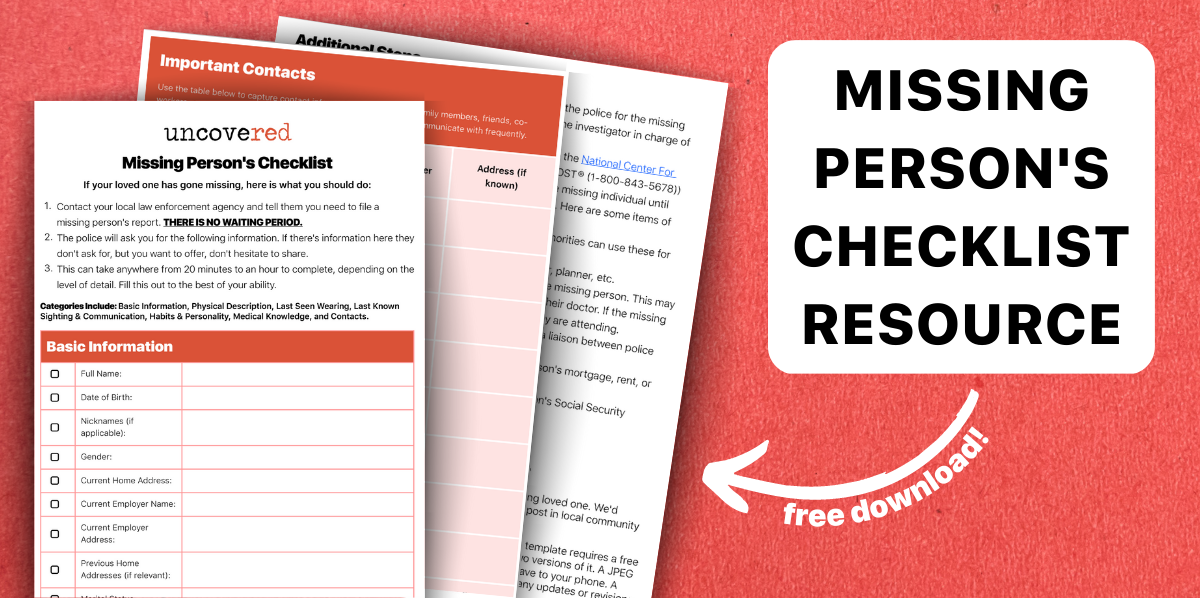Every year, more than 600,000 people go missing in the United States, ranging from young children to older individuals. Not only that, but it is currently estimated that nearly 4,400 unidentified bodies are recovered each year. Roughly 25% remain unidentified after one year.
Be prepared if the unthinkable happens. Support and resources are available.
Enter your email to get our Missing Person's Checklist
What happens if my loved one goes missing?
Call 911 immediately. There is no waiting period. The first 48 hours of investigating are crucial.
It does not matter if the person you’re concerned about is over 18, if you worry about wasting the police department’s time, or if the person lives a high-risk lifestyle and you fear that they’ll get in trouble. Do not wait. If you have a legitimate reason to believe your loved one has gone missing, report it as soon as possible.
How do I report someone as missing?
When you call your local law enforcement agency, they will have a list of questions for you about the person.
The checklist can take you anywhere from 20 minutes to an hour to complete, depending on the level of detail. Have this handy while speaking with investigators. The categories of questions include basic information, physical description, last seen wearing, last known sighting and communication, habits and personality, medical knowledge, and contacts.
Some questions may be difficult to answer, like trying to remember what they were last seen wearing or trying to remember if they had upcoming plans.
It’s okay to take a moment to focus while collecting information for investigators.
If you’re reporting a child as missing, it is recommended also to contact the National Center for Missing and Exploited Children. Their 24-hour call center can be reached at 1-800-THE-LOST (1-800-843-5678). Consider contacting your state’s missing person clearinghouse for additional support.
What do I do next?
Create a missing person’s poster and share it in person and on social media. The police do not typically create missing posters.
These require a free Canva account to edit.
Utilize local community groups on Facebook to help raise awareness. Make sure the post is shareable. On the state level, there are many Facebook groups dedicated to sharing missing-person posters.
Make physical copies of the posters and hang them up in your local grocery stores, banks, train and bus stations, movie theatres, schools, shopping centers, and more. If there are specific locations you know your loved one would frequent, make sure to put posters there as well.
How do I get the media to care?
Getting media attention for a missing person can be a difficult and emotional process, but it is an important step in finding them. By following these tips, you can increase the visibility of the case and help bring the missing person home.
Contact local TV stations, newspapers, and radio stations and ask them to cover the story of the missing person. Most media outlets will have a tips or contact email address or phone number listed on their home page. Provide as much information as you can, including photos and descriptions. Be sure to include your contact information so reporters can get back to you.
While reaching out to members of the media, it’s important to discuss with family and close friends who will be the point-person for interviews. You can decide on whomever is most comfortable, or closest to the individual — there is no right or wrong person.
Another way to get attention is to offer a reward. Consider offering a reward for information leading to the safe return of the missing person. This can encourage people to come forward with tips, and can also make the case more appealing to reporters.
Lastly, don’t forget that media also means social media. The more information you can provide to people wanting to help, the more likely it is that someone will come forward with information that can help find the missing person.
Who else do I contact online?
These databases are great places to look at in terms of accessing resources and raising awareness.
The Charley Project — Profiles over 9,000 cold cases of missing children and adults from the United States. www.charleyproject.org
NamUS — NamUs (National Missing and Unidentified Persons System) is a national information clearinghouse and resource center for missing, unidentified, and unclaimed person cases across the United States. www.namus.gov
Black and Missing Foundation, Inc. — Awareness of missing persons of color; provides vital resources and tools to missing persons’ families and friends and educates the minority community on personal safety. www.blackandmissinginc.com
DNA Doe Project — This organization is an exciting new initiative that uses genetic genealogy to identify John and Jane Does. www.dnadoeproject.org
National Center for Missing and Exploited Children — The clearinghouse reporting center for all issues related to the prevention of and recovery from child victimization. www.missingkids.org
Missing and Murdered Indigenous Women Database — A working database that logs cases of missing and murdered indigenous women, girls, and two-spirit people, from 1900 to the present. www.sovereign-bodies.org/mmiw-database
Trans Doe Task Force — A collective database of cold cases in which the subject may have been transgender or gender-variant. www.transdoetaskforce.org
Check out the Uncovered Citizen Detective guide to learn more about how to amp up your digital literacy around cold cases or other database resources.

